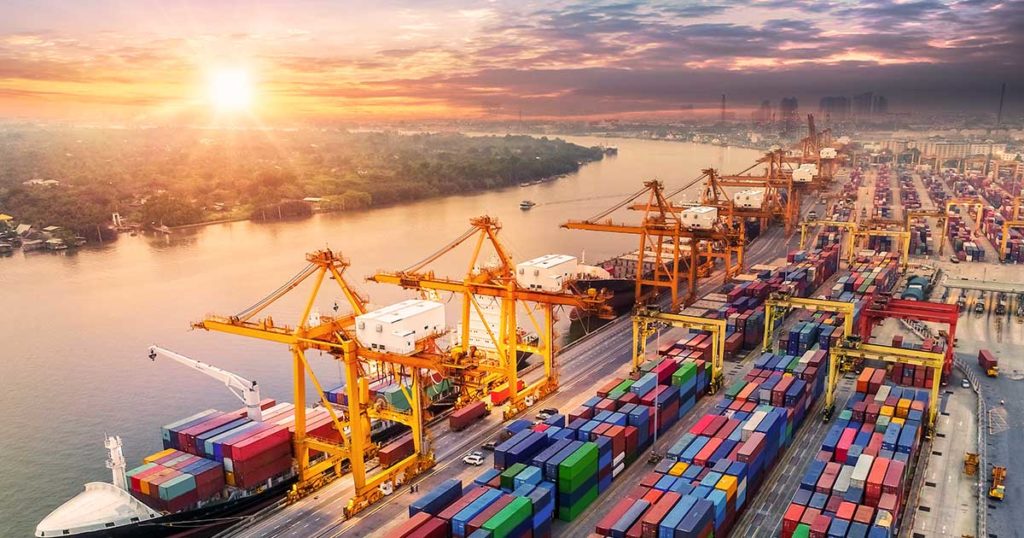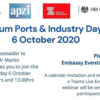Although the movement of vessels in ports might seem chaotic, more and more of these vessel movements and navigation decisions are not taken ad-hoc, on an individual basis nor on board of ships sailing through. The traffic of vessels in ports requires more coordination than what one can see at a first sight.
Integrated traffic coordination center
Vessels sailing through ports have to respect priority conditions, unloading/loading schedules at terminals’ berths, bunkering schedules, infrastructure capacity limitations such as lock passages etc. Developing an integrated traffic coordination center within a Smart Port Ecosystem is key.
We had an interview with Stefan Breitenbach, head of Project Department at Port of Hamburg Marketing. He explains the benefits of having a traffic coordination center to further consolidate a Smart Port Ecosystem.
How did innovation at the port of Hamburg get started?
Breitenbach: Innovation might arise from different initiatives or come from stakeholders that are not directly related to the port activity. At the port of Hamburg, the most experienced types of stakeholders to deliver innovation are the terminal operators and the port authority. But innovation is also coming from other players, like inland navigation, forwarders, shippers (e.g. players from the automotive industry) or IT industry (e.g. start-ups). Yet, there is a lot of fragmentation on the innovation market on who delivers innovation.
The main trends for smart developments at the port of Hamburg are with regard to the following topics:
- Coordination of vessels traffic (Hamburg Vessel Coordination Center)
- Energy use (using the energy capacity of HGV’s to store and stabilize grid imports, FRESH project)
- Telematics (5G beds)
- Infrastructure stability checks with robots or drones
- Intelligent infrastructure (building digital twins)
- Slot booking at terminals’ landside (with the introduction of ML algorithms for yard optimization processes)
- Truck platooning (vehicle to infrastructure communication links)
- Security of shipping
These developments have one thing in common: they manage to engage more and more port users once they proved they bring benefits.
“Once a solution is proven, then the rest will follow.”
Stefan Breitenbach, head of Project Department at Port of Hamburg Marketing
The most recent development that is still under expansion is the Hamburg Vessel Coordination Center (HVCC). The HVCC is a joint venture between the two container terminal operators in the Port of Hamburg, Hamburger Hafen und Logistik AG (HHLA) and EUROGATE Container Terminal Hamburg GmbH (CTH). HVCC department Nautical Terminal Coordination (NTC), which coordinates the large size vessels (such as container, bulk, roro, cruise, etc.) approaching the Port of Hamburg, covers 100% of all relevant vessels in their coordination systems. NTC is financed by terminals, who stand for 70% of the traffic. (including not only cargo vessels, but also cruises). The department Feeder Logistics Center (FLZ) coordinates around 50% of the Hamburg feeder and barge terminal calls.
What were the main barriers in developing a Smart Port Ecosystem?
According to Stefan Breitenbach, the main barriers in developing a smart port ecosystem in the port of Hamburg were often linked to data sharing and gaining the trust of stakeholders to share data, data protection and people working in the port. The same resistance was also observed in the HVCC case.
- The gain of trust is usually done over several years through discussion sessions on the benefit of sharing data. For example, for shipping lines there is the advantage of spending less time within the port, so they work more efficiently; on the other side for the terminal operators, there are also benefits as they can use the berths much faster again.
- Another barrier is the data protection (a lot of data is needed by the track and trace applications). Yet, the track and trace applications are not always easy to implement, as there is a need to set a data protection barrier, so that one cannot track individuals like dock workers, captains, pilots, etc.
- The people working in the port show reticence to new technologies or IT systems, as there is a silent fear for losing jobs.
Solutions for the future
The port community system provider DAKOSY is currently working on an upgrade of the export message platform. EMP 4.0 – the Export Management Platform 4.0 is an internet-based cloud solution that enables holistic, digitalized and integrated handling of export processes. By linking all process participants along the transport chain, existing local platforms and applications, as well as numerous bilateral coordination processes are all bundled into a single system.
The transparent availability of all transport-related data and its round-the-clock accessibility at a central location for all parties involved in the process allows a high degree of planning security as well as more efficient transport processing, making it faster and more cost-effective. The platform was developed in cooperation with a group of market players and therefore represents a broad spectrum of practical use cases.
The technological innovation projects started at the Port of Hamburg usually involve a limited number of stakeholders. Innovation is often supported by private companies. The industry can act faster and with less (administrative) challenges. Once a solution is proven, then the rest will follow. In the case of the stabilization of energy use, there are sometimes spill over benefits on the surrounding communities (e.g. private energy users and the grid network providers). This benefits spillover contributes to consolidate even more the Smart Port Ecosystem and encourage other stakeholders to develop other innovation.
What is still to be done to build a Smart Port Ecosystem?
The work still to be done for the port of Hamburg to be a full smart port is linked to rolling out its technological solutions to much more customers. There is work to be done on the standardization of procedures for vessels or cargo handling, for data transfer and linking IT solutions that are currently built up or in use. The collaboration with relatively big technology providers is done when needed and based on what is expected by the city administration in specific fields of interest, like emissions reductions or other public services. Yet, these fields of interest are constantly being revised. The biggest missing resource is the financial capacity to invest even more in innovation. This is especially true for SMEs now concentrating on the core business and not really on research and innovation because there is hardly any money for that, says Stefan Breitenbach.
By Valentin Carlan – Post-doc Researcher University of Antwerp



